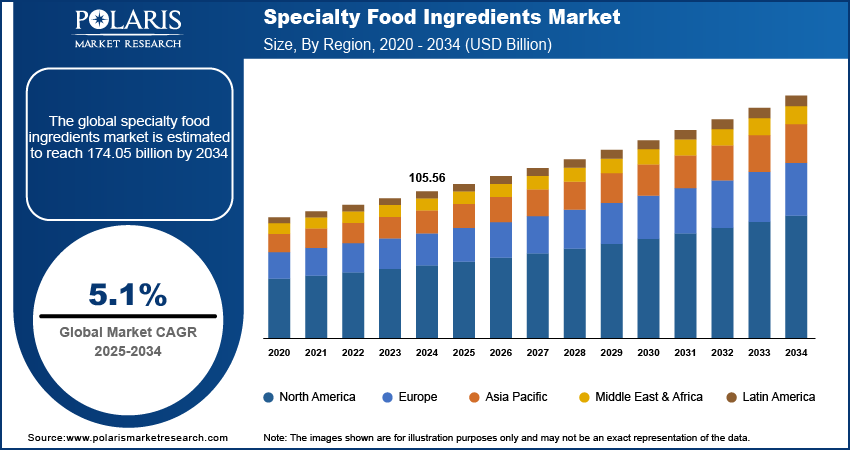Specialty Food Ingredients Market Projected to Reach USD 174.05 Billion by 2034, Growing at a CAGR of 5.1%

The specialty food ingredients market was valued at USD 105.56 billion in 2024 and is projected to grow from USD 110.85 billion in 2025 to USD 174.05 billion by 2034, registering a CAGR of 5.1% during the forecast period.
Key Market Trends & Insights
- Growing Demand for Clean Label Products: Consumers are increasingly seeking foods with recognizable, natural ingredients, boosting demand for specialty additives like natural flavors, colors, and preservatives.
- Rising Popularity of Functional Foods: Specialty ingredients such as probiotics, antioxidants, and plant-based proteins are gaining traction for their health benefits in immunity, digestion, and overall wellness.
- Expansion of Plant-Based and Allergen-Free Alternatives: The surge in vegan, gluten-free, and allergen-conscious diets is driving innovation in specialty ingredients tailored to these preferences.
- Technological Advancements in Ingredient Processing: Innovations in food tech are enabling better taste, texture, and shelf life while maintaining nutritional value and regulatory compliance.
Market Size & Forecast
Market Size Value in 2025: USD 110.85 billion
Revenue Forecast by 2034: USD 174.05 billion
CAGR: 5.1% from 2025 to 2034
Request for Free Sample:
Market Overview
The specialty food ingredients market plays a vital role in enhancing the taste, texture, functionality, and nutritional profile of a wide range of food and beverage products. These ingredients include flavors, colors, preservatives, emulsifiers, enzymes, sweeteners, and nutritional additives that meet evolving consumer demands for quality and variety. As consumer lifestyles shift toward health, convenience, and indulgence, specialty ingredients are essential in meeting both regulatory standards and consumer expectations.
This market is experiencing steady growth due to increasing awareness of nutrition, rising demand for clean-label and fortified food products, and the expansion of processed food consumption globally. Specialty ingredients are also being adopted across various segments such as bakery, confectionery, dairy, beverages, snacks, and functional foods. Manufacturers are focusing on research and development to innovate novel ingredients that align with dietary trends and sustainability goals, while complying with safety and labeling regulations across different regions.
Key Market Growth Drivers:
- Health and Wellness Trends: Increasing consumer preference for foods that offer added health benefits is driving demand for functional and nutritional specialty ingredients.
- Rise in Processed and Packaged Foods: Rapid urbanization and busy lifestyles have led to greater consumption of ready-to-eat and processed foods, boosting ingredient usage.
- Clean Label and Transparency Movement: Demand for natural, minimally processed, and transparent ingredients is reshaping product formulations globally.
- Innovation in Food Technology: Advances in food processing and ingredient synthesis are enabling the development of novel specialty ingredients with improved functionality.
- Growing Vegan and Allergen-Free Markets: The rise of plant-based diets and dietary sensitivities is fueling demand for specialized alternatives in food formulations.
Market Challenges:
- High R&D and Production Costs: Developing innovative and compliant specialty ingredients requires significant investment in research, testing, and quality control.
- Strict Regulatory Requirements: Food safety and labeling regulations vary across countries, making it challenging for manufacturers to maintain compliance.
- Supply Chain Complexities: Sourcing natural and sustainable raw materials can be inconsistent and impacted by environmental and geopolitical factors.
- Consumer Skepticism Toward Additives: Despite health claims, some consumers remain wary of added ingredients, especially artificial or unfamiliar names, impacting adoption.
- Price Sensitivity in Emerging Markets: High costs of specialty ingredients may limit their accessibility and market growth in price-sensitive regions.






